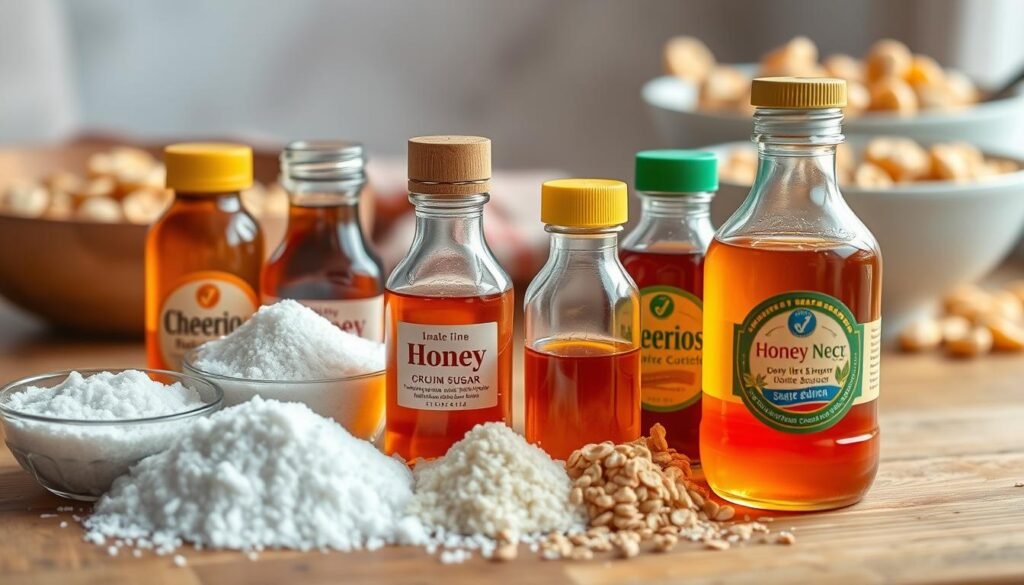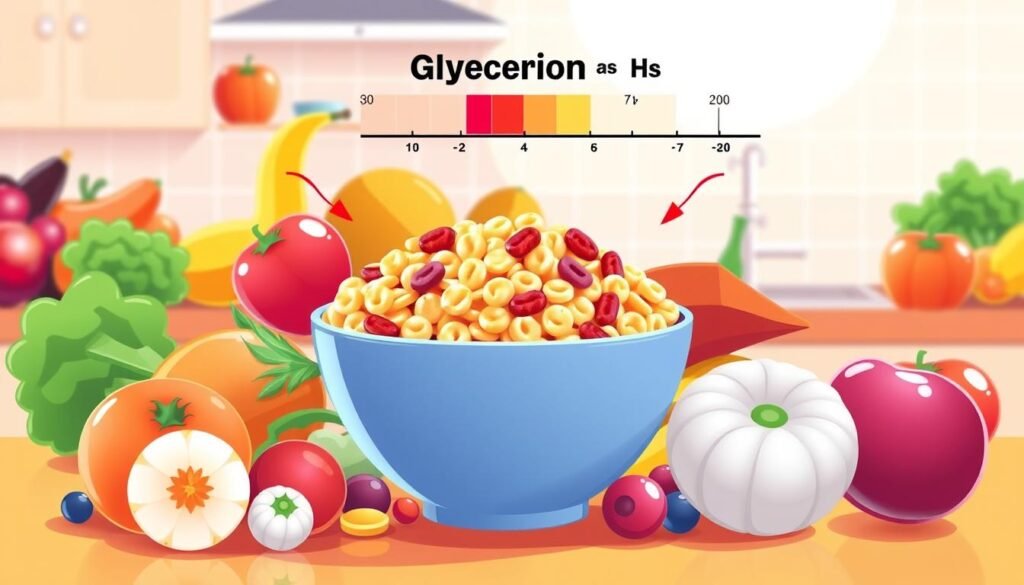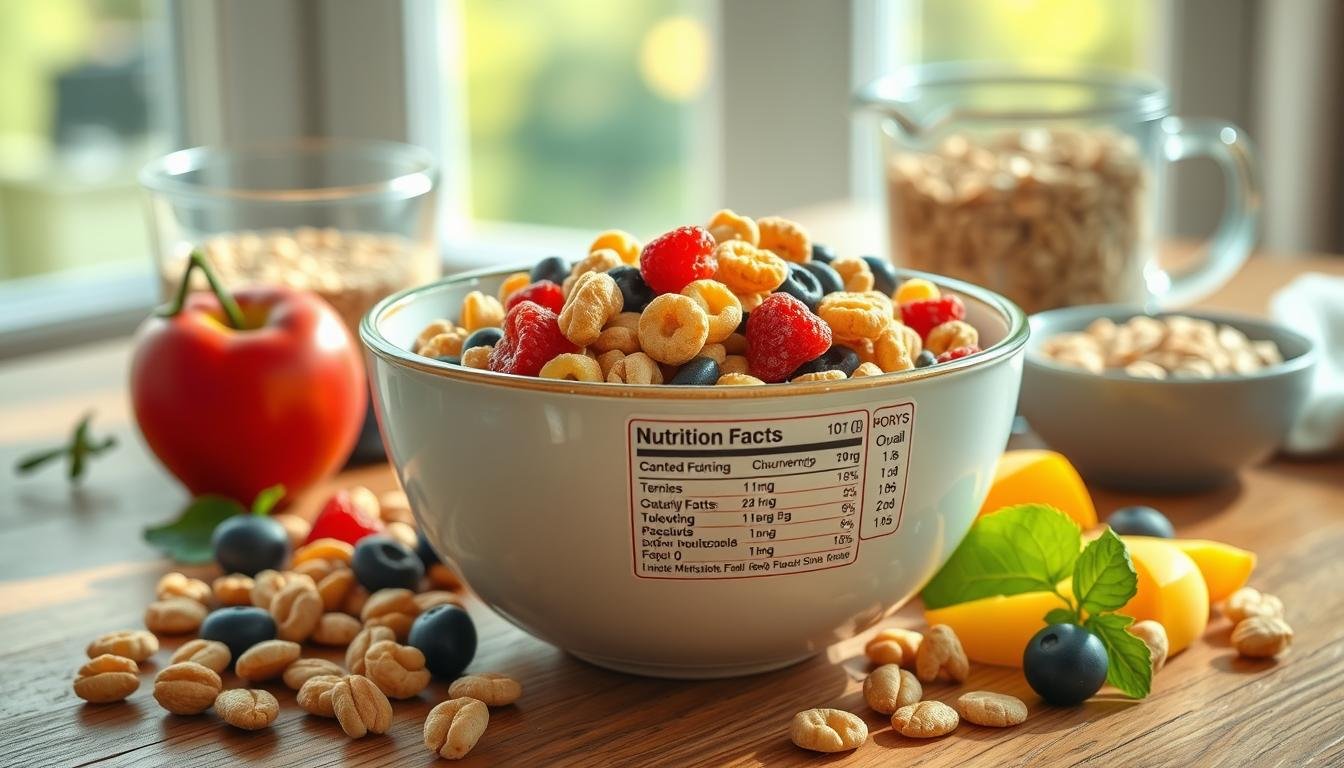Cheerios are a beloved breakfast cereal in many American homes. But, is it really a healthy choice? Are Cheerios healthy? We’ll look into the nutrition facts, the benefits of whole grains, and how Cheerios affect our health.
Key Takeaways
- Cheerios are whole-grain cereal, providing a good source of fiber and essential nutrients.
- The original Cheerios variety is low in added sugars, making it a relatively healthy breakfast option.
- Cheerios offers a range of options, including protein-packed and gluten-free varieties, to cater to various dietary needs.
- Moderation is key when it comes to Cheerios, as portion sizes and additional toppings can impact the overall nutritional value.
- Cheerios have been associated with benefits for heart health and weight management, thanks to their soluble fiber content.
Cheerios: A Whole Grain Breakfast Staple
Cheerios, a popular breakfast cereal, often comes up in discussions on health due to its low sugar content and high fiber. When examining the GI of Cheerios (glycemic index), original Cheerios rank moderate, which means they impact blood sugar gradually, making them a balanced choice for energy. The question, are original Cheerios healthy, largely depends on dietary goals. With whole-grain oats as the main ingredient, they offer heart-health benefits and may support lower cholesterol levels. However, it’s worth noting that they lack protein and contain some processed ingredients. For a more balanced meal, pairing them with a protein source like Greek yogurt or nuts can enhance their nutritional value. While original Cheerios provide some health benefits, it’s essential to consider portion sizes and pairings to avoid blood sugar spikes and ensure a well-rounded diet.
Whole grains are key to a healthy diet, and Cheerios are a great example. They’re made from whole grain oats, offering fiber, complex carbs, and important vitamins and minerals. Cheerios make it easy to add whole grains to your morning routine.
Understanding the Benefits of Whole Grains
Whole grains are full of nutrients that boost health. They’re rich in fiber, which helps with digestion and keeps you full. They also have B vitamins, iron, and antioxidants that fight chronic diseases.
The Cheerios Variety: From Original to Protein-Packed
The original Cheerios recipe is still a favorite, but the brand has grown. Now, there are many options, from classic whole-grain cereal to protein-rich varieties. Cheerios offers a variety of healthy choices for breakfast.
| Cheerios Variety | Key Features |
|---|---|
| Original Cheerios | Made from whole grain oats, low in added sugars |
| Cheerios Protein | Features added protein from soy and pea sources |
| Honey Nut Cheerios | Sweetened with honey, contains whole grain cereal and fiber content |
| Cheerios Oat Crunch | Combines crunchy oat clusters with classic Cheerios |
Cheerios has grown to meet today’s health needs. It offers a variety of whole-grain cereal options for a nutritious start to the day.
Cheerios Nutrition: Breaking Down the Numbers
Understanding Cheerios’ nutritional value is key. This iconic breakfast cereal has a balanced nutritional profile. It can help with overall health and well-being.
Cheerios is known for its fiber content. A single serving has 3 grams of fiber. This supports digestive health and helps you feel full. It’s great for weight management and regular bowel movements.
When it comes to carbohydrates, Cheerios has 20 grams per serving. It has a low glycemic index. This means it won’t cause quick spikes in blood sugar. It’s good for those watching their glycemic index and blood sugar.
Cheerios are also packed with vitamins and minerals. A single serving gives you a lot of important nutrients. These include:
- Vitamin B6
- Vitamin B12
- Iron
- Calcium
- Magnesium
These nutrients are vital for heart health, energy, and body function. Cheerios is a nutritious way to start your day.
While Cheerios isn’t the only answer to good health, it’s a valuable part of a balanced diet. Knowing its nutrient levels helps you make smart choices. It can be a great addition to your daily routine.
Cheerios can be a solid choice for a *heart-healthy diet*, thanks to their whole-grain oats and relatively low impact on *blood sugar levels*. The *glycemic load (GL)* of Cheerios is moderate, meaning it has a balanced effect on blood sugar, which is helpful for those looking to maintain steady energy levels. *General Mills* uses *mixed tocopherols added to preserve freshness*, which are natural antioxidants that help extend shelf life without artificial additives. By incorporating Cheerios into your diet, you may also *reduce the risk* of heart disease, thanks to their fiber content and balanced nutrient profile. As with any food, pairing Cheerios with protein or healthy fats can optimize nutrition and sustain energy throughout the day.
Fiber Content: Keeping You Regular and Satisfied
Fiber in Cheerios is key for a healthy breakfast. It helps with digestion and keeps you feeling full and regular all day.
How Fiber Aids Digestion and Weight Management
Cheerios’ fiber is great for your digestive health. Soluble fiber, like in Cheerios, keeps bowel movements regular and prevents constipation. It supports healthy digestion and may help with weight management.
Fiber also helps you feel full longer. Foods high in fiber, like Cheerios, digest slowly. This slows down the release of nutrients, reducing hunger and aiding in weight control.
| Fiber Content | Serving Size | Fiber per Serving |
|---|---|---|
| Cheerios Original | 1 cup | 3 grams |
| Cheerios Honey Nut | 1 cup | 2 grams |
| Cheerios Oat Crunch | 1 cup | 4 grams |
Cheerios have different amounts of fiber, with Oat Crunch having the most. Adding Cheerios to your diet can help you reach your daily fiber goals. It supports your digestive and weight management efforts.
“Fiber is essential for maintaining a healthy digestive system and promoting feelings of fullness, making it a valuable addition to a well-rounded breakfast.”
Added Sugars: Decoding the Sweet Truth
Breakfast cereals often have added sugars, which worries health-conscious parents. Cheerios, a favorite, is no different. Let’s explore the added sugars in this popular cereal.
The original Cheerios has a bit of added sugar. A serving has 1 gram. This might seem small, but kids might eat more or have other sugary foods.
The American Heart Association suggests limits on added sugars. For most adults, it’s 6 teaspoons (25 grams) a day. For kids, it’s 3 to 6 teaspoons (12 to 24 grams) daily.
Parents should watch the sugar in Cheerios, especially in sweetened types. Honey Nut and Chocolate Cheerios have 9 and 10 grams per serving, respectively.
| Cheerios Variety | Added Sugars (per serving) |
|---|---|
| Original Cheerios | 1 gram |
| Honey Nut Cheerios | 9 grams |
| Chocolate Cheerios | 10 grams |
Knowing the sugar in Cheerios helps parents choose better. Finding a balance between whole grains and sweetness is key for a healthy breakfast.

Are Cheerios Healthy for Kids?
Parents often ask if Cheerios are a healthy choice for kids’ cereal. The answer is yes, Cheerios can be a nutritious start to the day. They are made from whole grains, which are full of fiber, vitamins, and minerals. These are all important for growing kids.
Exploring Age-Appropriate Portion Sizes
The right amount of Cheerios for kids depends on their age and needs. Here’s a general guide:
- Toddlers (1-3 years): 1/4 to 1/2 cup of Cheerios per serving
- Preschoolers (4-5 years): 1/2 to 3/4 cup of Cheerios per serving
- Elementary-aged children (6-11 years): 3/4 to 1 cup of Cheerios per serving
Adjust the portion size based on your child’s hunger, activity, and diet. Adding fresh fruit, low-fat milk, or protein can make breakfast more balanced and nutritious.
| Age Group | Recommended Cheerios Portion Size |
|---|---|
| Toddlers (1-3 years) | 1/4 to 1/2 cup |
| Preschoolers (4-5 years) | 1/2 to 3/4 cup |
| Elementary-aged children (6-11 years) | 3/4 to 1 cup |
It’s important to offer Cheerios as part of a varied diet. This ensures kids get all the nutrients they need for healthy growth.
The Glycemic Index: Cheerios’ Impact on Blood Sugar
The glycemic index (GI) is key for a healthy breakfast. It shows how food affects blood sugar. Knowing this helps people manage their health.
Cheerios have a glycemic index (GI) rating of 74, placing them in the high GI category for breakfast cereals. For individuals with diabetes or those managing blood sugar levels, lower-GI options, like wheat bran cereals such as Kellogg’s All-Bran or Post 100% Bran, may be more suitable. These alternatives offer a slower, more gradual release of glucose, helping to maintain stable blood sugar.
Cheerios is a favorite breakfast cereal. But how does it affect blood sugar? Let’s look into it.
Unraveling the Glycemic Index of Cheerios
The original Cheerios has a low GI, around 74-77. This makes it a low-glycemic index food. It’s good for those who want to control their blood sugar.
Whole grain oats in Cheerios help keep blood sugar stable. They are digested slowly. This prevents big spikes and drops in blood sugar.
| Cheerios Variety | Glycemic Index |
|---|---|
| Original Cheerios | 74-77 |
| Honey Nut Cheerios | 69 |
| Multigrain Cheerios | 67 |
Different Cheerios have slightly different GI values. Honey Nut and Multigrain have even lower values. This is because of extra ingredients and fiber.

Cheerios is a good choice for a healthy breakfast. It keeps blood sugar stable. This is great for people with diabetes or those trying to lose weight.
Cheerios and Heart Health: The Cholesterol Connection
The fiber in Cheerios is key to a healthy heart. The soluble fiber in this cereal helps lower cholesterol. This is important for reducing heart disease risk.
Understanding the Role of Soluble Fiber
The soluble fiber in Cheerios binds to cholesterol in the gut. It helps remove it from the body. This can lower overall cholesterol, especially the bad LDL cholesterol.
Studies show eating 3 grams of soluble fiber daily, like in Cheerios, can lower LDL cholesterol by 5 to 10 percent. Cheerios is a great choice for heart health.
The fiber in Cheerios also makes you feel full and helps with regular bowel movements. This supports both heart and digestive health.
“Incorporating Cheerios into a balanced diet can be a simple yet effective way to support heart health and manage cholesterol levels.”
Knowing how soluble fiber in Cheerios works helps you choose better breakfasts. It’s a step towards a healthy heart.
Conclusion: Balancing the Cheerios Equation
Cheerios can be a good choice for a healthy diet. It offers whole grains and fiber. But, it’s important to think about the whole picture, especially for kids.
Even though Cheerios has less sugar than many cereals, watch out for flavored varieties. Sticking to the original recipe is a healthier option.
Adding Cheerios to a diet full of fruits, veggies, and lean proteins is smart. This way, you get a balanced meal. Knowing how whole grains and fiber affect your health helps you make better choices. This way, Cheerios can be a key part of a healthy breakfast or snack.
FAQ
What are the nutritional benefits of Cheerios?
Cheerios are made from whole-grain oats. They are a good source of fiber, vitamins, and minerals. They are also low in fat and calories, making them a healthy breakfast choice.
Do Cheerios have added sugars?
The original Cheerios variety has minimal added sugars, about 1 gram per serving. But, some flavors like Honey Nut Cheerios have more added sugars. This is something to think about when picking a healthy breakfast cereal.
How does the fiber content in Cheerios affect digestion and weight management?
Cheerios are a good source of fiber. This fiber helps with digestion and makes you feel full. It also helps with weight management by slowing down nutrient absorption and keeping you feeling full.
What is the glycemic index of Cheerios, and why is it important?
Cheerios have a low glycemic index. This means they don’t cause blood sugar to spike quickly. This is good for keeping energy levels stable and supporting metabolic health.
Are Cheerios suitable for children?
Cheerios can be a healthy breakfast for kids. They are low in sugar and full of whole grains and nutrients. But, it’s key to watch portion sizes and the sugar in some varieties, especially for young kids.
How do Cheerios contribute to heart health?
The soluble fiber in Cheerios can help lower cholesterol. This is good for heart health. Plus, Cheerios are made from whole grains, making them a heart-healthy breakfast choice.
Are Cheerios a healthy cereal?
Cheerios can be a relatively healthy cereal choice, as they are low in sugar, high in whole grains, and provide some fiber and vitamins.
What are the nutrition facts for Cheerios?
A serving of Cheerios (3/4 cup) contains 100 calories, 2g of fat, 19g of carbs, 3g of fiber, and 3g of sugar.
How much sugar is in Cheerios?
Original Cheerios contain only 1g of sugar per serving, making them a low-sugar cereal option.
Are Honey Nut Cheerios healthy?
Honey Nut Cheerios have more sugar than original Cheerios, with 12g per serving. They are less healthy than the original version.
What are the benefits of eating Cheerios?
Key benefits of Cheerios include its whole grain content, fiber, and relatively low sugar and calorie levels compared to many other breakfast cereals.
Are there any downsides to Cheerios?
Potential downsides are the lack of protein and the fact that the whole grain content, while better than many cereals, is still relatively low.
How do Cheerios compare to other healthy cereal options?
Cheerios are generally healthier than many sweetened, high-sugar cereals, but may be less nutritious than some whole grain, high-fiber options like oatmeal or bran cereals.



